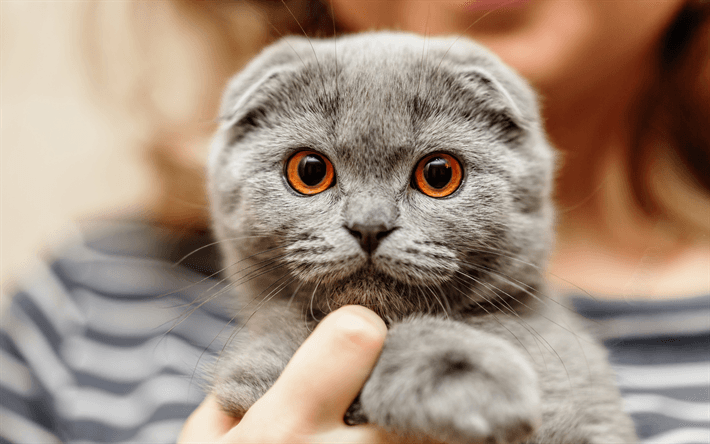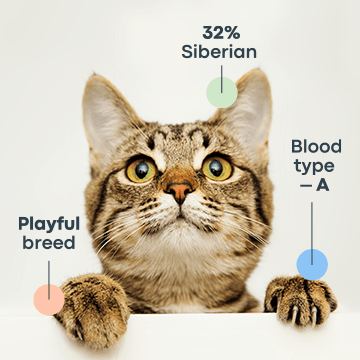Genetic mutations are permanent changes in a cat’s DNA. While these changes can have different impacts on an individual – helpful, harmless, or harmful – they are important sources of genetic diversity in populations of all species, including cats. Some of these genetic changes can result in interesting differences in physical appearance. Here are some changes in a cat’s body shape and features caused by genetics.
Background Information
If you have seen cats with folded or rounded ears, you must have wondered how some cats have such unique characteristics. These fascinating traits result from genetic mutations (genetic changes), leading to changes in the physical appearance of cats, often known as body-type mutations (changes in a cat's body shape or features caused by genetics).
Do you know these unusual genetic changes would quickly disappear in the wild? Well, that is because felines with unique traits would fail to breed in large numbers. However, this is not the case with domestic cats, who are normally adored for these body-type genetic changes, resulting in these unique traits being selected and preserved within the domestic cat population. While these traits attract lots of attention, it is essential to understand that these genetic changes can be harmful (or even deadly when a cat inherits the same gene mutation from both parents).
Variations in Ears

Typically, cats have erect and slightly pointed ears. Several identified mutations impact the form and shape of feline ears:
1. Folded ears. This trait is associated with a gene that is passed down even if only one parent carries it, which in this case is the Fd gene. This genetic change is specific to the Scottish Fold breed. Their ears are folded forward and down to different degrees of folding. However, this gene is also associated with cartilage defects such as swollen feet and a thickened tail. The genetic change is harmful when a cat inherits one copy of the mutation from each parent, in which case it causes osteochondrodysplasia. This is why breeders breed folds only with non-folds to avoid homozygous fold offspring.
2. Curled ears. This unusual trait is associated with the Cu gene, which is associated with the American Curl breed. Fortunately, no harmful defects associated with this gene have been identified yet. However, the ears of these cats need to be handled carefully as the ear cartilage is fragile. Regular ear cleaning is also required because more of the inner ear is exposed in comparison to typical ear forms.
3. Rounded ears. Rounded ears were originally observed in a cat in Italy and some free-roaming cats in Texas. These ears are rounded rather than pointed in shape. While the carriers of the trait in Texas actually died out, the one found in Italy is being assessed for breed potential.
4. Four ears. This feature is associated with a genetic change that only shows up if both parents carry the gene. The genetic change results in four ear flaps (additional flaps do not lead to additional organs of hearing). Sometimes, due to these duplicated ears, a cat’s eyes may be reduced in size and the jaw slightly undershot. Carriers of this trait can be relatively inactive and lethargic and may struggle with possible interferences of brain functioning. This genetic change also seems to be lethal, with most kitten carriers actually dying in utero. Despite this data, the majority of recently reported four-eared cats have actually been healthy, indicating that there may be more genes involved in this unusual ear configuration.
Variations in Tails

1. Japanese Bobtail "bobbed tail." The bobbed tail in the Japanese Bobtail breed is a unique feature associated with a genetic change that gets passed down no matter the parent's gender and here it is the Japanese Bobtail gene, Jb. Because the mutation is dominant, both homozygotes and heterozygotes will have bobbed tails. Unlike other unusual tail shapes, the mutation causing bobbed tails is harmless and is not linked to lethality or skeletal disorders.
2. Manx tailless. This is a trait caused by a harmful genetic change in a gene that is passed down even if only one parent carries it, which in this case is the Manx tailless gene, M. Homozygous carriers (MM) die before birth while heterozygous carriers (Mm) are either tailless or have very short, stumpy tails. Sometimes they can also exhibit skeletal and organ defects, with some Manx cats dying before ever reaching 12 months of age.
3. Short tails. Tails that are simply "short" in length can be very difficult to distinguish from bobbed or Manx tails. Shortened tails can occur in many different pure or mixed breeds and can be caused by different genetic changes, most of which are still being investigated.
4. Curly tails. Tails looping over from the back come in different forms and can be caused by different mutations. One such mutation has been developed into the new experimental breed called American Ringtail. The breed started with a Californian cat named Solomon in 1998. The genetic change identified in this cat doesn’t seem to be associated with any health issues. Curly tailed cats were bred with Ragdolls and American Shorthairs.
Variations in Paws

1. Syndactylism. This is a trait associated with a gene that causes fewer toes, called the Split Foot gene (Sh). The change in this dominant gene gives it a so-called "lobster-claw" appearance.
2. Polydactylism. This is a trait associated with different dominant and recessive genes causing a higher number of toes than normal. To learn more about this unusual appearance, read our blog about polydactylism here.
Variations in Height and Size
1. Munchkin legs. This is the trait of shortened legs, and it is caused by the change in the Munchkin gene Mk, which is a dominant gene that is passed down even if only one parent carries it. Homozygous (Mk Mk) carriers may be at a higher risk of dying as the kittens are very small in the litter. However, the genetic change doesn’t seem to cause impaired mobility or spinal problems, and Munchkin cats are not disabled despite having short legs. The anomaly is not achondroplasia but can be either hypochondroplasia or pseudoachondroplasia (meaning that the long bones of the legs are affected, and other bodily proportions remain unaffected).
2. Teacup-sized Persians. These are very small, diminutive but proportional Persian cats whose size is caused by a genetic change passed down through their parents. It was first identified in a male Persian named Treker in 1995. Today, Teacup Persians are a separate breed from Persians, and not all of them are descended from Treker. Most of these kittens today originate from Silver and Golden color divisions.

Variations in Coat Colors And Patterns
Cat coats come in diverse patterns and colors. There are several genes associated with different colors and patterns, as well as fur length and texture. You can find our summary of all important coat-related genes here.
Fun Facts About Cat Mutations
Here are some fun facts about mutations in cats:
Japanese Bobtails are considered good luck. The cat that is famous for being featured in Japanese statues and ceramic figurines is known as Maneki-Neko (meaning beckoning cat) and is believed to bring good fortune.
According to the Guinness Book of World Records, a polydactyl ginger tabby cat named Jake holds the world record for “the most toes in the world” — a whopping 28 toes! The cat had seven toes on each paw, and every toe had its own claw, pad, and bone structure.
Polydactyl cats are also believed to bring good luck. Not only that, Ernest Hemingway loved polydactyl cats. After he died in 1961, his previous home in Key West, Florida, became a home and a museum for his cats, which currently has about 50 descendants of his cats - around half of which are polydactyl.
Four-eared cats have been reported since at least 1946 when a tabby kitten was born with four ears, small eyes, and an underbite.
More recently, a gray four-eared cat from Ankara, Turkey became a public sensation and is adored for their extra ears and white heart on their chest.
Conclusion
Understanding your feline companion’s genetics plays a crucial role in keeping them healthy and you can learn a lot with the Breed + Health Cat DNA Test. From extra toes and ears to unique coat patterns and colorations, genetics can give fascinating characteristics to our cats that make them even more special.
Frequently Asked Questions
Do purebred cats have more genetic deformities?
Yes, purebred cats are more prone to genetic deformities than mixed-breed cats due to inbreeding and selective breeding.
Why do some cats have polydactylism?
Polydactyly in cats results from a genetic change that is passed down through a dominant gene, which means only one parent needs to carry the gene for a kitten to have extra toes.




